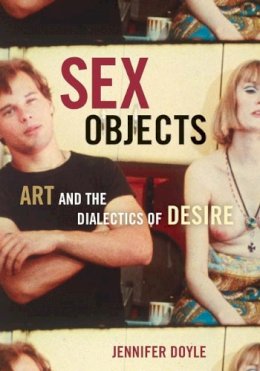
Stock image for illustration purposes only - book cover, edition or condition may vary.
Sex Objects: Art And The Dialectics Of Desire
Jennifer Doyle
€ 30.99
€ 30.26
FREE Delivery in Ireland
Description for Sex Objects: Art And The Dialectics Of Desire
Paperback. Num Pages: 224 pages, 24 halftones. BIC Classification: AGHX; VFVC. Category: (G) General (US: Trade). Dimension: 254 x 180 x 12. Weight in Grams: 464.
The declaration that a work of art is “about sex” is often announced to the public as a scandal after which there is nothing else to say about the work or the artist-controversy concludes a conversation when instead it should begin a new one.
Moving beyond debates about pornography and censorship, Jennifer Doyle shows us that sex in art is as diverse as sex in everyday life: exciting, ordinary, emotional, traumatic, embarrassing, funny, even profoundly boring. Sex Objects examines the reception and frequent misunderstanding of highly sexualized images, words, and performances. In chapters on the “boring parts” of Moby-Dick, the scandals that dogged the painter Thomas Eakins, the role of women in Andy Warhol's Factory films, “bad sex” and Tracey Emin's crudely evocative line drawings, and L.A. artist Vaginal Davis's pornographic parodies of Vanessa Beecroft's performances, Sex Objects challenges simplistic readings of sexualized art and instead investigates what such works can tell us about the nature of desire.
In Sex Objects, Doyle offers a creative and original exploration of how and where art and sex connect, arguing that to proclaim a piece of art “about sex” reveals surprisingly little about the work, the artist, or the spectator. Deftly interweaving anecdotal and personal writing with critical, feminist, and queer theory, she reimagines the relationship between sex and art in order to better understand how the two meet-and why it matters.
Jennifer Doyle is associate professor of English at the University of California, Riverside. She is coeditor, with Jonathan Flatley and José Esteban Muñoz, of Pop Out: Queer Warhol.
Moving beyond debates about pornography and censorship, Jennifer Doyle shows us that sex in art is as diverse as sex in everyday life: exciting, ordinary, emotional, traumatic, embarrassing, funny, even profoundly boring. Sex Objects examines the reception and frequent misunderstanding of highly sexualized images, words, and performances. In chapters on the “boring parts” of Moby-Dick, the scandals that dogged the painter Thomas Eakins, the role of women in Andy Warhol's Factory films, “bad sex” and Tracey Emin's crudely evocative line drawings, and L.A. artist Vaginal Davis's pornographic parodies of Vanessa Beecroft's performances, Sex Objects challenges simplistic readings of sexualized art and instead investigates what such works can tell us about the nature of desire.
In Sex Objects, Doyle offers a creative and original exploration of how and where art and sex connect, arguing that to proclaim a piece of art “about sex” reveals surprisingly little about the work, the artist, or the spectator. Deftly interweaving anecdotal and personal writing with critical, feminist, and queer theory, she reimagines the relationship between sex and art in order to better understand how the two meet-and why it matters.
Jennifer Doyle is associate professor of English at the University of California, Riverside. She is coeditor, with Jonathan Flatley and José Esteban Muñoz, of Pop Out: Queer Warhol.
Product Details
Publisher
University of Minnesota Press United States
Number of pages
224
Format
Paperback
Publication date
2006
Condition
New
Weight
464g
Number of Pages
224
Place of Publication
Minnesota, United States
ISBN
9780816645268
SKU
V9780816645268
Shipping Time
Usually ships in 4 to 8 working days
Ref
99-2
About Jennifer Doyle
Jennifer Doyle is associate professor of English at the University of California, Riverside. She is coeditor, with Jonathan Flatley and Jose Esteban Munoz, of Pop Out: Queer Warhol.
Reviews for Sex Objects: Art And The Dialectics Of Desire
"Like a brassy fag hag crashing a gay sex party, Jennifer Doyle mixes it up here with a queer lot. Whether she's just watching or actively participating, whether turned on or bored, thinking or crying, or most likely all of these at once, Doyle shows how crucial a queer feminist perspective is to understanding the erotics of art." - Douglas Crimp, University of Rochester, author of Melancholia and Moralism"
